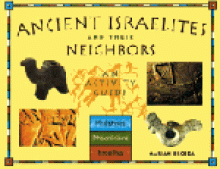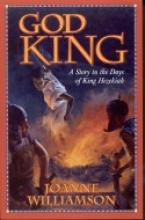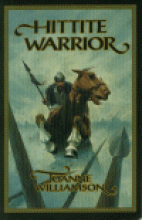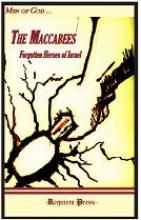History Ancient Israel
Ancient Israelites and Their Neighbors: An Activity Guide
Subject(s):
Setting:
Grade / Age level:
Review:
Ancient Israelites and Their Neighbors: An Activity Guide is not what I had expected. Because I had seen it advertised in a teacher supply store, I was anticipating lesson plans and a very "teacher-y" feel to the book. Instead, it is written as if it were for the student to read himself from front to back, much like he would read an interesting story. Covered in the text are discussions of the Philistines, Phoenicians, and the Israelites, cultures which are largely under-represented in elementary history studies.
The uncluttered pages with line drawings and black-and-white photographs focus on daily life rather than on wars, military leaders, and historically significant events. There are no review questions, suggested writing or research topics, or test materials. However, there are descriptions of the history and geography, architecture, clothing, writing, work, food, and religion of each of the three groups discussed. Also included are very simple maps, a brief summary, a timeline, and a bibliography for further reading.
The book contains long textual passages of several pages, interwoven with activity and project directions. The fairly-involved projects include sewing and adorning costumes, the building of models and ships, dye-making, and cooking. Measurements and recipes are given in standard American unit measures and in metric. These are not simple projects that my own young children could complete on their own; parental supervision and participation is definitely required. In spite of the effort needed, the projects are creative and memorable; completing a select few of them would appeal to even the most history-resistant student.
I noted, however, a few problems from the perspective of a Catholic homeschooling family. First, the majority of the history of the Israelites is derived from the Bible, but I found it difficult to reconcile the author's opinion that only parts of the Bible are reliable. A particular translation of the Bible is not referenced in the lengthy bibliography. The author notes that archeology can help to show that Biblical events really occurred, but she says that anything in the Bible about God, miracles or spiritual matters cannot be proven because that is a matter of faith. In addition, although the Bible is used as a historical reference, secular dating conventions (BCE rather than BC, and CE rather than AD) are used, adding another element of confusion. As with all secular materials, the author presents an equality amongst all religions, ancient and modern.
Secondly, there are several mentions made of child sacrifices in both the Israelite and Phoenician cultures. I think that this is unnecessary in a book intended for elementary students. The author writes (on page 44) that the Bible even mentions some Israelites sacrificing children to other gods. We know that this is meant to describe unacceptable sacrifices, but the text could be very confusing to young children.
Another confusing statement is this from page 126: "One of the greatest legacies of the Philistines was their effect on the Israelites. We might not even have the Bible. Even if we did have a Bible, it would not be the same Bible we have today."
It is difficult to find materials for younger children when studying this geographical area and time period of history. Because of that, I can recommend this book, with the qualification that the teaching parent is aware of its shortcomings. It may be best to use this book as an enrichment to a textbook or Biblical-based historical unit study rather than as the primary source of information.
The uncluttered pages with line drawings and black-and-white photographs focus on daily life rather than on wars, military leaders, and historically significant events. There are no review questions, suggested writing or research topics, or test materials. However, there are descriptions of the history and geography, architecture, clothing, writing, work, food, and religion of each of the three groups discussed. Also included are very simple maps, a brief summary, a timeline, and a bibliography for further reading.
The book contains long textual passages of several pages, interwoven with activity and project directions. The fairly-involved projects include sewing and adorning costumes, the building of models and ships, dye-making, and cooking. Measurements and recipes are given in standard American unit measures and in metric. These are not simple projects that my own young children could complete on their own; parental supervision and participation is definitely required. In spite of the effort needed, the projects are creative and memorable; completing a select few of them would appeal to even the most history-resistant student.
I noted, however, a few problems from the perspective of a Catholic homeschooling family. First, the majority of the history of the Israelites is derived from the Bible, but I found it difficult to reconcile the author's opinion that only parts of the Bible are reliable. A particular translation of the Bible is not referenced in the lengthy bibliography. The author notes that archeology can help to show that Biblical events really occurred, but she says that anything in the Bible about God, miracles or spiritual matters cannot be proven because that is a matter of faith. In addition, although the Bible is used as a historical reference, secular dating conventions (BCE rather than BC, and CE rather than AD) are used, adding another element of confusion. As with all secular materials, the author presents an equality amongst all religions, ancient and modern.
Secondly, there are several mentions made of child sacrifices in both the Israelite and Phoenician cultures. I think that this is unnecessary in a book intended for elementary students. The author writes (on page 44) that the Bible even mentions some Israelites sacrificing children to other gods. We know that this is meant to describe unacceptable sacrifices, but the text could be very confusing to young children.
Another confusing statement is this from page 126: "One of the greatest legacies of the Philistines was their effect on the Israelites. We might not even have the Bible. Even if we did have a Bible, it would not be the same Bible we have today."
It is difficult to find materials for younger children when studying this geographical area and time period of history. Because of that, I can recommend this book, with the qualification that the teaching parent is aware of its shortcomings. It may be best to use this book as an enrichment to a textbook or Biblical-based historical unit study rather than as the primary source of information.
Additional notes:
This title was donated for review by Chicago Review Press
Reviewed by:
First reviewed:
5-7-05
God King: A Story in the Days of King Hezekiah
Subject(s):
Setting:
Grade / Age level:
Review:
God King is a very engaging tale set in Egypt and Judah in approximately 701 B.C. Like Joanne Williamson's other Bethelehem Books title Hittite Warrior, God King helps the reader connect major stories from the Bible with contemporary events in secular history. The Egyptian perspective gives us a more complete look at the fierceness of the Assyrians and the great danger they posed to all the surrounding nations - providing greater insight into God's miraculous intervention on behalf of Jerusalem and King Hezekiah.
Taharka is one of the lesser sons of the Egyptian pharaoh, Shabaka. Through an act of mercy that was forbidden to one in his position, he is unexpectedly chosen as successor to his father. Life as Pharaoh is strange and unpleasant to him as he adjusts to a new life of strange eating restrictions, limited interaction with common people and bizarre rules of etiquette. To make matters worse, a whole web of threats and intrigue follows, involving his jealous half-brother Shabataka, who had been groomed for the throne, and the threat of Assyrian spies and invasion. Finally Taharka escapes an attempt on his life and flees the country in disguise in the company the king of Judah's ambassador, who had come to Taharka asking for assistance against the Assyrians. Taharka encounters the seemingly invincible armies of the Assryians and their cruel ways before making his way into a besieged Jerusalem. There Taharka comes to appreciate the faith, integrity and ingenuity of King Hezekiah and discovers how he can use his position to prevent a new threat.
You can find the Biblical account of King Hezekiah in the Book of Isaiah. Ages 10 and up.
Taharka is one of the lesser sons of the Egyptian pharaoh, Shabaka. Through an act of mercy that was forbidden to one in his position, he is unexpectedly chosen as successor to his father. Life as Pharaoh is strange and unpleasant to him as he adjusts to a new life of strange eating restrictions, limited interaction with common people and bizarre rules of etiquette. To make matters worse, a whole web of threats and intrigue follows, involving his jealous half-brother Shabataka, who had been groomed for the throne, and the threat of Assyrian spies and invasion. Finally Taharka escapes an attempt on his life and flees the country in disguise in the company the king of Judah's ambassador, who had come to Taharka asking for assistance against the Assyrians. Taharka encounters the seemingly invincible armies of the Assryians and their cruel ways before making his way into a besieged Jerusalem. There Taharka comes to appreciate the faith, integrity and ingenuity of King Hezekiah and discovers how he can use his position to prevent a new threat.
You can find the Biblical account of King Hezekiah in the Book of Isaiah. Ages 10 and up.
Additional notes:
This title was donated for review by Bethlehem Books.
Reviewed by:
First reviewed:
7-4-02
Hittite Warrior
Subject(s):
Setting:
Grade / Age level:
Review:
This is a rather interesting story, set in Biblical times (about 1200 B.C.) of a great battle led by the Hebrew Barak (at the time of Deborah) and told from the perspective of a young Hittite Warrior, Uriah - one of the enemy. The story gives the reader a real sense of the culture of the time - from the land of the Hittites, to Ancient Israel, to the major Canaanite cities of Tyre and Sidon (where the people fearfully sacrifice a child to the god Moloch in time of difficulty). Through the shock of becoming involved in rescuing a child from Moloch against his will, Uriah becomes involved with the Hebrews and eventually comes to see difficulties with the pagan beliefs. The author also ties in details of Ancient Egypt and Ancient Greece from the same time period.
It's so important to have books which tie Biblical and other historical events together - helping us to better understand the Old Testament.
It's so important to have books which tie Biblical and other historical events together - helping us to better understand the Old Testament.
Reviewed by:
First reviewed:
3-17-2000
The Maccabees, Forgotten Heroes of Israel
Subject(s):
Setting:
Grade / Age level:
Review:
Based on the 1st and 2nd book of Maccabees of the Douay-Rhiems version of the Bible, The Maccabees, Forgotten Heroes of Israel is an epic tale of faithfulness to God and heroism in the face of unbelievable odds.
With the exception of a few passages of dialogue, this tale is a narrative retelling. A typical passage reads as follows. "As soon as Judas had made an end of speaking, he rushed suddenly upon them. Seron and his host were overthrown before him. He pursued Seron by the descent of the Bethoron to the plain, and there fell eight hundred men of Seron's army; the rest fled into the land of the Philistines" (34).
Once Judas forms his army, a pattern seems to set in. A king, governor, or a commander of a huge force threatens to attack Judas and his men. Judas' men become fearful. He offers them encouragement, calling upon the Lord to protect them. This revives their spirits. Then they go out and slay several thousand. Throughout the story, there are enough twists and turns to keep the reader's interest.
Why so much bloodshed? They wanted to practice their faith freely without the threat of persecution, or even death. They also wanted to restore and rededicate the Temple.
The book also includes an Introduction by Warren H. Carroll, which offers historical background to the story, summarizing the plot and a Publishers Preface, which expresses his motive for bringing this story of manly heroism to print. The Maccabees, Forgotten Heroes of Israel makes this important story from the Old Testament come alive and accessible.
Recommended for ages 14 and up.
With the exception of a few passages of dialogue, this tale is a narrative retelling. A typical passage reads as follows. "As soon as Judas had made an end of speaking, he rushed suddenly upon them. Seron and his host were overthrown before him. He pursued Seron by the descent of the Bethoron to the plain, and there fell eight hundred men of Seron's army; the rest fled into the land of the Philistines" (34).
Once Judas forms his army, a pattern seems to set in. A king, governor, or a commander of a huge force threatens to attack Judas and his men. Judas' men become fearful. He offers them encouragement, calling upon the Lord to protect them. This revives their spirits. Then they go out and slay several thousand. Throughout the story, there are enough twists and turns to keep the reader's interest.
Why so much bloodshed? They wanted to practice their faith freely without the threat of persecution, or even death. They also wanted to restore and rededicate the Temple.
The book also includes an Introduction by Warren H. Carroll, which offers historical background to the story, summarizing the plot and a Publishers Preface, which expresses his motive for bringing this story of manly heroism to print. The Maccabees, Forgotten Heroes of Israel makes this important story from the Old Testament come alive and accessible.
Recommended for ages 14 and up.
Reviewed by:
First reviewed:
10-29-05




